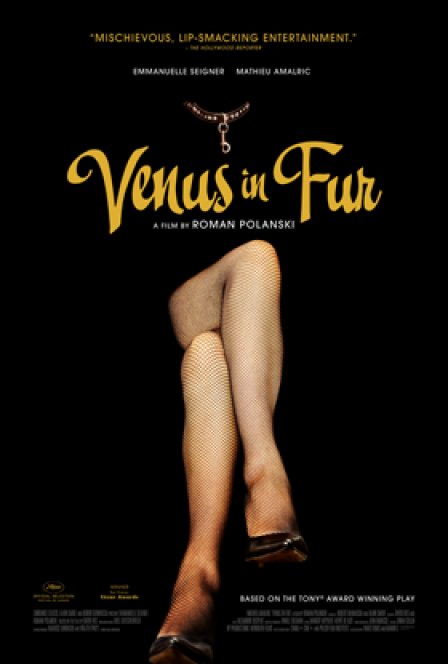A long tracking shot supernaturally drifts into a derelict theater on a stormy night in Paris. Thomas (Mathieu Amalric), a frustrated playwright with his first directing gig, is about to call it quits after a full day of shoddy auditions for the lead role. A brash and initially disheveled actress, Vanda (Emmanuelle Seigner), appears, convincing Thomas to hold one more audition by way of her charm and preternatural familiarity with the play’s source material: Leopold von Sacher-Masoch’s proto-BDSM novella Venus in Fur.
Venus in Fur is Roman Polanski’s third film adapted from a play (the other two being 2011’s Carnage and 1994’s Death of a Maiden), co-writing the screenplay with the playwright himself, David Ives. The adaption is strictly contained to the theater unfolding in the present moment. Pawel Edelman’s slow-panning camera presents the actors without being invasive, a detached observer who only serves the film in bare pragmatism.
Fortunately, Almaric’s and Seigner’s brilliant, energetic performances make this film compelling, guiding the audience along the serpentine and erotically-charged power reversals. As soon as Vanda shows up at the audition, she begins to take complete control. She manipulates the stage lighting, dons eerily-appropriate props, and gives, at first, directorial suggestions that soon morph into firm commands. Like stage actors, their performance is total — their plays of dominance apparent in every slow fasten of a leather boot, bat of an eyelash, near kiss, and open stance. By the end of the film, Almaric is intoxicated with submission.
Much of these manipulations stem from Vanda’s expert blurring of reality and fiction, deftly implicating Thomas in the play itself (at one point, she swaps out the character’s name for his) and abruptly switching from in-character to commentary on the play to meta-commentary on Thomas’ psychological motivations. Vanda skillfully times these interruptions to bring the inherent chauvinistic atmosphere of the play — and, by extension, of the theater world — under scrutiny. Thomas is quick to react to her critiques of sexism personally, like many men privileged enough to have been in a relationship with a woman in our patriarchal culture. Unable to really grasp and describe what really draws him to the play, he angrily invokes the ineffable, the vague notion that there exists a raw essence of art — the attraction of which is impossible to describe. Vanda, pushing her advantage, shows the audience how childishly evasive Thomas is of the issue at hand.
Sure, Venus in Fur is a “textbook good movie,” one whose simplicity, character exchanges, and symbolic prop use would lend itself to being analyzed in a screenwriting course. But besides its fluidity, exceptional performances by Seigner and Almaric, and faint supernatural elements, the film suffers from being a little too straightforward, and at its worst, it can be unimaginative and preachy. Besides the performances, there is little art to the production, which is strange considering it’s a product of one of the foremost American auteurs of the past 40 years. Shots capture the action with a neutral eye, letting the actors’ performances color the scene alone. There is some clever sound design that mirrors the surreal blending of fiction and reality, but even this falls flat as a sort of expected gimmick (fake fireplace makes roaring fire sound). The film is missing the dark, impressionistic, and tortured fingerprints that make Polanski’s body of work so subtly mystic and compelling. It’s neither boring nor incomplete, just underwhelming for a director whose near-legendary career and personal struggles have already set the bar impossibly high.

